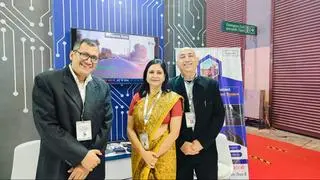This 28-year-old Indian company is the go-to vendor for the digital mapping needs of corporate biggies like McDonald’s, Apple, and Amazon, among others.
Arch-rival of Google Maps, MapMyIndia clocked ₹282 crore revenue in FY23, including ₹108 crore profit after tax (PAT) and an EBITDA margin of 41.9 per cent.
Its consumer app Mappls has 3 million downloads on Android and iOS, and its application programming interfaces (APIs) are used by popular platforms such as PhonePe, Paytm, and Cowin — extending MapMyIndia’s reach to nearly 300 million mobile phones.
CEO and Executive Director Rohan Verma dwells on the evolution of MapMyIndia from a software company to a full-stack provider of hardware and software solutions.
Could you recount MapMyIndia’s origin and 28-year journey?
MapMyIndia was started in 1995, with my parents’ [Rakesh and Rashmi Verma, both engineers who returned to India after a 12-year stint in the US] vision that, some day, 80 per cent of all data will have a location component and maps usage will be found across industries. At that time there was no digital map data in the country and they decided to fill this gap.
MapMyIndia did not stop at just building digital map data, we continuously built software and hardware solutions. Today, we offer solutions ranging from software for cars to software for enterprises, APIs, IoT [internet of things] devices, and even drone-based solutions.
MapMyIndia announced gadgets for cars and two-wheelers (such as GPS trackers, dash cameras, and smart helmet kits) in February 2023.
Could you tell us about your push into the hardware sector?
From 1995 to 2006, we were a pure-play software and data company. But around 2007, we felt that there would be a need for different types of hardware that can bring out the benefits of our maps and location-based software. Our first hardware product was a portable navigation system, which led us to becoming an automotive tier-one supplier [direct supplier to original equipment manufacturers]. Today, our hardware offerings include a variety of IoT devices such as GPS trackers, GPS health diagnostics, infotainment systems for cars, etc. However, 85 per cent of our business continues to be software-led.
How tough or easy has it been to compete with Google?
Google entered the digital map space globally in 2005, a good 10 years after us. We have only accelerated our innovations and technology since then and can proudly say that our maps and technology are no less than those of Google Maps. In fact, we offer many more features in our consumer app (Mappls).
The challenge for us has been on the consumer side. It has been proven by the Competition Commission of India and the courts that Google abused its dominance and engaged in anticompetitive activity to stifle competitors like MapMyIndia. With the new CCI ruling, hopefully, this equation will change and we will get a level playing field on the consumer side as well.








Comments
Comments have to be in English, and in full sentences. They cannot be abusive or personal. Please abide by our community guidelines for posting your comments.
We have migrated to a new commenting platform. If you are already a registered user of TheHindu Businessline and logged in, you may continue to engage with our articles. If you do not have an account please register and login to post comments. Users can access their older comments by logging into their accounts on Vuukle.